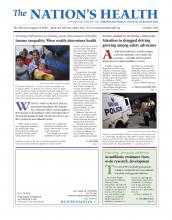Water safety
The Centers for Disease Control and Prevention in July released the 2016 Model Aquatic Health Code. An update from the 2014 edition, the code contains the latest evidence-based recommendations in areas such as management, construction and maintenance to lower risk for illness and injuries at facilities such as water parks and pools. For more information, visit www.cdc.gov/ncezid.
Global health
Columbia University Press in May published “The Five Horsemen of the Modern World: Climate, Food, Water, Disease and Obesity.” Authored by Daniel Callahan, PhD, MA, the book looks at the factors that contribute to public health dangers in the five areas, the barriers to making improvements and the strategies needed to make progress. For more information, visit http://cup.columbia.edu.
One health
The U.S. Department of Agriculture in June launched an online portal for information about one health. One health recognizes that the health of animals, humans and the environment are interconnected. The portal includes links to recent one health-related news headlines and blogs as well as URLs for information on antimicrobial resistance, avian influenza and influenza in swine. For more information, visit www.usda.gov/wps/portal/usda/usdahome?navid=onehealth.
Chronic disease
The Accelerating Medicine Partnership in June updated its Type 2 Diabetes Knowledge Portal. New features include the ability to customize navigation of the portal and access to data from more than 100,000 DNA samples. The portal opened in 2015 and is a product of the National Institutes of Health’s Accelerating Medicines Partnership. For more information, visit http://www.type2diabetesgenetics.org.
Maternal and child health
The Association of Maternal and Child Health Programs in July released “Sustaining and Diversifying Family Engagement in Title V MCH and CYSHCN Programs.” The survey report, which looked at how Title V-funded programs support family and consumer engagement, is broken down into seven briefs that cover topics such as how to create a culture of family engagement and the roles of family, staff or consultants. For more information, visit www.amchp.org/programsandtopics/family-engagement.
Disability
Disability.gov in July launched a new page on its website of quick links to resources on how to find information for topics such as rental assistance programs, financial aid for students with disabilities attending college and job training opportunities. For more information, visit www.disability.gov/disability-govs-quick-links.
Respiratory illness
The Centers for Disease Control and Prevention’s Division of Global Migration and Quarantine in July redesigned its website on non-pharmaceutical interventions. The updated website features information such as training on how to use non-pharmaceutical interventions to respond to influenza pandemics for local, state, tribal and territorial public health workers. The division is part of CDC’s National Center for Emerging and Zoonotic Infectious Diseases. For more information, visit www.cdc.gov/nonpharmaceutical-interventions.
Child health
The World Health Organization in August published “Making Every Baby Count: Audit and Review of Stillbirths and Neonatal Deaths.” The publication is a resource for countries and health care systems on how to identify infant mortalities and use that data to boost maternal and child health care services for the future. For more information, visit www.who.int.
Behavioral health
The Substance Abuse and Mental Health Services Administration in August published “Approaches in Implementing the Mental Health Parity and Addiction Equity Act: Best Practices from the States.” The report looks at examples of how programs in seven states targeting people with behavioral health and substance use issues best exemplified facets of the Mental Health Parity and Addiction Equity Act of 2008. For more information, visit http://store.samhsa.gov.
- Copyright The Nation’s Health, American Public Health Association









